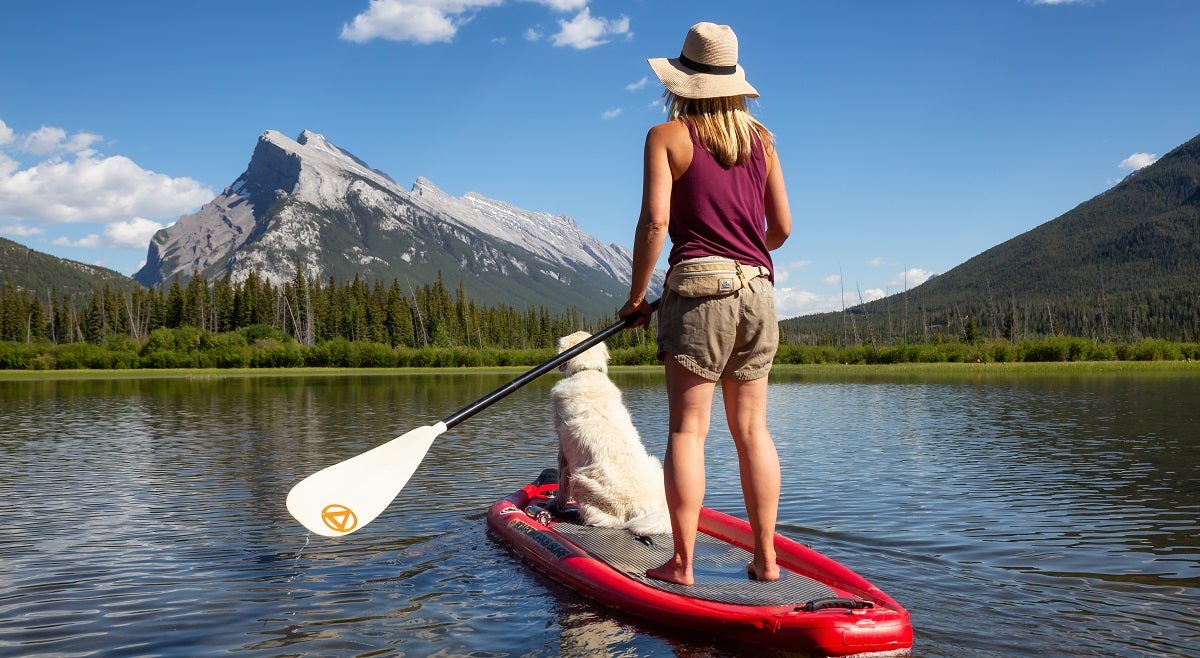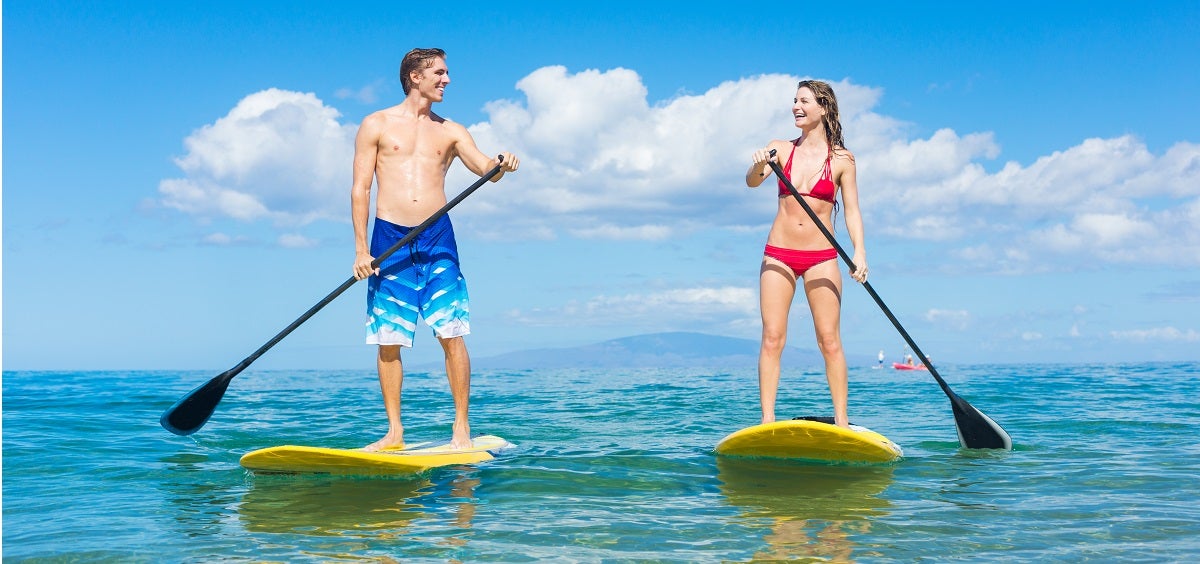
Our Editors independently research, test, and rate what we feel are the best products. We use affiliate links and may receive a small commission on purchases.
Stand up paddleboarding can be as calm or exciting a sport as you want it to be. However, most paddleboarders start with the basics on the quiet waters of rivers and lakes. When it comes to watersports, paddleboarding can be one of the most peaceful. It can also be one of the least intimidating.
To make easier for you, we’ve created a guide for all the equipment you’ll need to get started and what you need to do to prepare for your trip. Then, there are 7 simple steps to go from getting your board in the water to on your feet and paddling. Don’t forget to check out the top 10 tips to beginning paddle boarding below!
Equipment:
- SUP or iSUP: A SUP, or stand up paddle board, is designed specifically for this sport. An iSUP is an inflatable version that can make storage and transportation much easier. It’s important to choose the right SUP for your height, weight, and intended use.
- Paddle: There are many different SUP paddles and they also come in different lengths based on your height.
- Leash: SUP leashes can be coiled or straight and can attach to the ankle or calf. The type of leash you choose depends mostly on the conditions in which you are paddle boarding and your own preference.
- Pump: If you chose to go with an iSUP, You will need a pump to inflate it. There are manual pumps and electric iSUP pumps. If you plan on using your iSUP frequently, go with an electric model. They will save time and relieve you of a workout getting it inflated.
- Life Vest or PFD: A life vest is also referred to as a Personal Flotation Device. Even if a PFD isn’t required where you are paddleboarding, it is a vital piece of safety equipment. See our PDF buying guide for more information on how to choose the right one.
- Safety Gear: Other safety gear you’ll want to have with you includes a whistle so you can be found if you fall and lose your board as well as a light or headlamp. The light will help you find your way if you plan on staying out after sunset or lose track of time. Don’t forget a SUP board bag and roof rack to keep it protected when transporting it.
- Protective Gear: The SUP protective gear you need is similar to the gear necessary for all watersports. Sunscreen, sunglasses, and a hat protect you from the sun. A UV shirt, rash guard, or wetsuit are especially helpful if you plan on spending a lot of time on the water.
- Snacks: Food is fuel and you will be burning a lot of calories while paddleboarding. You can place them in a waterproof board bag, in a vest, or in a waist pack.

7 Easy Steps for Beginner Paddleboarding
While learning how to maintain your balance can take some practice, the steps for getting onto your board and into a standing position are quite simple.
- “Step” Onto Your Board: Because you stand up on your board, many beginner paddle boarders mistakenly believe that you step onto your board. This is the quickest way to land in the water! Instead, walk your board out into deeper water and climb onto it while keeping as much of your body in contact with the board as possible. Your ultimate goal is to sit on your knees in the middle of the traction pad.
- Grip the Paddle: Most SUP paddles have a T-handle at the top. This helps with leverage when paddling through the water. Grip the T-handle loosely and place your other hand on the bar of the paddle further down. Your hands should be shoulder-width apart.
- Paddle Away from Shore: While still on your knees, slowly paddle out to more open water, making sure there is plenty of distance from the shore, any trees, and other people enjoying the water.
- Move to Your Feet: Almost as tricky as getting onto your board is moving to your feet. You will use your paddle for stability with it on the board in front of you and both hands on the T-grip. Lift one knee to put your weight on the ball of the foot and then the other. While still on the balls of your feet, lift your upper body using the paddle for leverage and then slowly move from a squat to a standing position.
- Keep Proper Stance: You always want to keep your weight on the balls of your feet rather than your heels. This will allow you to adjust your balance much more quickly.
- Use Your Entire Body: If you only use your arms and shoulders to paddle, you will get tired and sore very quickly. While your legs and hips are working hard to keep you stable on the board, be sure your waist and torso are helping the rest of your upper body will the paddling.
- Have Fun!
Our Top 10 Stand Up Paddleboarding Tips for Beginners
We’ve enjoyed paddleboarding for years but that doesn’t mean we’ve forgotten what it was like when we first started out! Here are our top 10 tips for those just starting out.
Tip #1: Practice Your Technique
Believe it or not, you can practice your technique right in your own living room. Remove any fins from your board and place it flat on the floor. You might want to put a towel under it. Practice the steps of going from kneeling to standing several times until it’s second nature. You can also practice your paddling.
Tip #2: Check the Weather
You never want to get to the lake for a fun day on the water while it’s bright and sunny only to find yourself in the middle of a thunderstorm a few hours later. Be sure to check the weather forecast before you leave home.
Tip #3: Use the Buddy System
Even experienced paddleboarders make sure they aren’t out on the water by themselves. Always have someone with you in case you need help.
Tip #4: Check Wind Direction
It will always be easiest if you are paddling with the wind at your back instead of into it. This is especially true when you first start out. While it’s not always possible, keeping the wind direction in mind can keep you from getting too tired too quickly.
Tip #5: Double-Check Your Paddle
An easy mistake for many beginners is facing the paddle in the wrong direction. The paddle will always be more efficient when it’s facing the right way.
Tip #6: Know Your Limits
Think twice before going out if the water is choppy, the winds are strong, or even if there are waves and you don’t feel comfortable tackling them just yet. With practice and a lot more experience, these things won’t be a problem.
Tip #7: Don’t Look Down
When we are trying to keep our balance in any situation, we often look at our feet. This can actually make it much harder to stay balanced. Instead, try to keep your gaze focused on a specific point in the distance. Some use the horizon, and some use a buoy or other marker.
Tip #8: Fall Away from the Board
Your SUP or iSUP is very rigid and can hurt if you fall onto it or into it! To prevent injury, you’ll need to learn how to fall correctly. Yes, that sounds bad but falling is a part of any watersport and learning how to do it the right way can prevent injury. You always want to fall away from your board and resist the temptation to try to catch yourself on the board.
Tip #9: Loosen Your Grip
While still learning how to keep our balance, we sometimes grip the paddle too tightly. This grip can tire us out, especially our arms, and make it difficult to get back to shore.
Tip #10: Take Breaks Often
Stand up paddle boarding is a whole-body workout, especially if you are trying out yoga while on your paddle board. It can get tiring quickly especially if you aren’t used to it. If you are feeling tired, find a shady spot and sit down on your board. Pull out a granola bar or other snack and a bottle of water to refuel.
Ready to Experience the Water in a New Way?
If you’re looking for a way to enjoy a local river or lake, or even the ocean, then paddleboarding might be perfect for you. With so many awesome choices when it comes to affordable SUP boards and with new inflatable SUPs called iSUPs, it’s never been easier to get started paddle boarding.
Grab some friends or plan a family trip to the water to give stand up paddle boarding a try. And once you are more comfortable on your board, considering paddle boarding with your dog!
